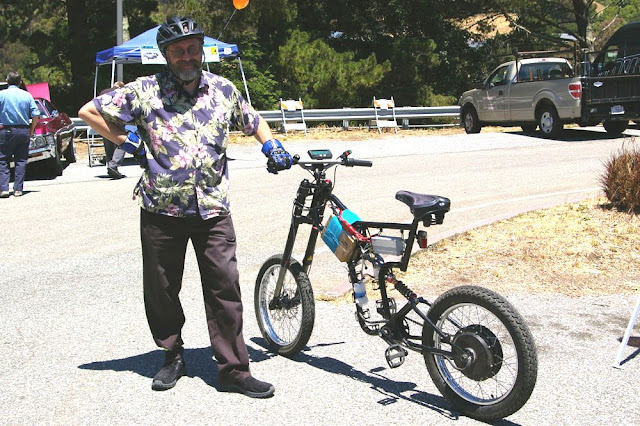San Pablo Reservoir on a Sunny Afternoon
Joined by acuteaero this time for a nice test ride. We did the Three Bears Loop. I hope he wasn't too bored. Nothing too exciting, though the weather was nice and there were a few cyclists out. One passed us going 50 mph on the Big Bear downhill.

But we blew by him on the uphill.

Charged last night and again now via the balancing leads with the Hyperion 1420i. At the moment I'm charging each 6S bank individually, later I may do 12S and 6S chunks for two hookups, or even use a second charger for the 6S part and charge them concurrently.

On the first paralleled charge cycle the third bank of 6S4P took forever to balance. These batteries were all individually charged and checked, but some were from an older batch and had sat around for weeks at full charge. The other batteries took a couple of hours to charge at the low initial rate, but the third block was balancing for another couple of hours when I finally interrupted it because it was time to go. It was at 97 percent, no not much to go, but it was going very slowly. On the charge after today's ride all three banks took between 80 and 90 minutes, so the balance seems to be sorted out.
It is convenient to have one small lower cover removed for easy access to charging connectors and getting the motor cabling out. If the lower right panel is left off this would also allow running a larger chainring which is appealing. I might consider making my own custom lower right hand cover that would facilitate a larger chainring and the charging connections.
This trip consumed about 12.1 amp hours, but the CA indicated 13.5. Comparing the charging amp hours to the CA it seems the shunt is about 1.5 milli ohms rather than the 1.7 I was using.
I also checked today to see if a metric allen wrench would work on the 6-32 panhead cap screws holding the covers on, and the 2mm fits perfectly.

I was looking for an old bike multi-tool that I purchased some years ago and didn't use. Found it, and it turns out to be a Topeak Alien. Amazing collection of tools in one compact package.
Ordered a seatpost mount Topeak MTX rack type V. From what I read these racks can break from too much weight and abuse (like carrying batteries and doing rough riding), but with the gentle riding and light trunk weight I need for commuting hopefully this won't be a problem. I'm also looking at ways of strengthening the rack.
Installed the mirrycle mirror today and really like it on this bike. There is no vibration so I can see a long way back. This is much better than my other bikes with the same mirror, the dual suspension (and weight?) seems to really make a difference in the stability.
It was interesting to compare the Cromotor to the HS3540 in acuteaero's BMX. The Kv of the HS is rated at 10.225, and the Cromotor 9.5. We were both running 18S packs, though the Borg's Turnigy voltage is slighly higher than the BMX's Kokams. The 2.5" moped tire was on the HS, and a 3.0" moped tire which is slightly larger diameter was on the Cromotor. Both the voltage and the tire size were in the direction to reduce the Kv difference of the motors. So the 18S Cromotor in the 17" moped tire tops out just under 40 mph, and the HS just over 40 mph. Of course we kept our speed at a legal 20mph except for some downhill sections.





